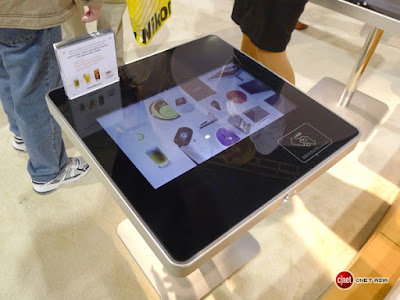will keep getting smaller, faster, more powerful, and more user-friendly, and that they
will eventually use voice, touch, gestures, and other alternative input methods more than
keyboards and mice. Portable computers and mobile devices will continue to be used as
primary computing devices at home and work, as well as while on the go. Tomorrow’s
home and business computers will likely not even look like today’s computers—instead
they may be built into walls, desks, appliances, and perhaps even jewelry and clothing. In
addition to their changing appearance, computers are expected to keep converging with
other devices and to continue to take on multiple roles to serve our personal needs, as
well as to control our household or office environment. Computers in the future may also
be able to offer multi-sensory output—enabling users to see, hear, feel, taste, and smell
output—and they will likely become even more environmentally friendly.
Emerging Input Devices
Because of the increasing amount of data entered into mobile devices today, these devices often have a keyboard or can be inserted into a keyboard dock or keyboard folio when a keyboard is needed. New input methods for mobile devices include tiny keyboards (such as on smart watches) that automatically zoom in on the part of the keyboard you touch to allow you to touch a larger key for your final selection, and the Swype app used with on-screen keyboards to supply input by continuously dragging through the letters in a word to spell that word .
 | |||
A keyboard is built into this portable case. |
KEYBOARD FOLIOS
In addition, voice input and speech recognition capabilities are increasingly being incorporated
into computers, smartphones, car navigation systems, and other devices to enable hands-free input. Specialty speech recognition systems are frequently used to control robots and other electronic equipment, such as those used by surgeons during surgical procedures.
 |
| SWIPE APP |
Touch, pen, and gesture input is beginning to be used with personal computers and is becoming the norm for mobile devices. The use of gesture input started with motion-sensitive gaming controllers, such as the Wii Remote and the Xbox Kinect. Today, gesture input is also used to detect gestures made in conjunction with large screen interactive advertising displays and it may soon be incorporated into computers of the future.
 |
| TABLE PCS |
One new trend in the area of touch input is the table PC - a large screen computer
either built into a table or designed to be used on a table, (such as the 27-inch table PC)
and that allows multi-touch input from multiple users. Table PCs can be used by several individuals at once to play games together, work together on a project, participate in an interactive museum display together, and so forth.
Emerging Output Devices
Some of the most recent improvements in display technology center on more versatile
output devices and new flat-screen technologies. For instance, recent improvements
in flat-panel display technology and graphics processing have led to several emerging
three-dimensional (3D) output devices, including 3D display screens for computers.
While traditional 3D displays (and most 3D televisions today) require special 3D glasses,
the newest 3D computer display products use filters, prisms, multiple lenses, and other
technologies built into the display screen to create the 3D effect and, as a result, do not
require 3D glasses.
Some 3D displays resemble conventional monitors; others are shaped
differently, such as the dome-shaped Perspecta 3D display that is used primarily for
medical imaging. 3D consumer products are increasingly available as well, such as the
Nintendo 3DS handheld gaming device.
 |
| Nintendo 3DS handheld gaming device |
Researchers at Intel Labs predict
that much of the Internet will use
realistic-looking 3D applications
by 2020.
Another emerging 3D output device is the 3D projector. Some 3D projectors are designed to project 3D images that are viewed with 3D glasses, similar to 3D televisions.
 |
| Technicolor 3D system for 35mm 3D Projection |
 | ||||||
Can be stand-alone or built into a mobile device; images
from the mobile device
are projected onto any surface.
Others are designed to project actual 3D projections or holograms. For instance,
holograms of individuals and objects can be projected onto a stage for a presentation, and
hologram display devices can be used in retail stores, exhibitions, and other locations to
showcase products or other items in 3D. Another emerging projection option that can be
used to project content to a small audience while on the go is the pico projector.
These pocket-sized projectors typically connect to a smartphone or portable computer to enable
the device to project an image (such as a document, presentation, or movie) onto a wall or other flat surface from up to 12 feet away.
3D PRINTERS
This printer can print objects up to the size of
a standard basketball.
When permanent 3D output is required, such as to print a 3D model of a new building
or prototype of a new product, 3D printers (which typically form output in layers using
molten plastic during a series of passes to build a 3D version of the desired output can be used.
3D printers are becoming available in a variety of sizes, from personal printers for printing smartphone cases, toys, jewelry, and other personal objects to professional printers for printing working product prototypes or custom manufacturing parts. They have even begun to be used to print medical implants using FDA-approved 3D material. One issue with the increased availability of 3D printers is the risk of them being used to print dangerous or illegal items, such as working plastic guns. In fact, after a 3D-printed gun was recently demonstrated firing standard bullets, lawmakers are considering enacting legislation to ban plastic weapons created by 3D printers.

























No comments:
Post a Comment